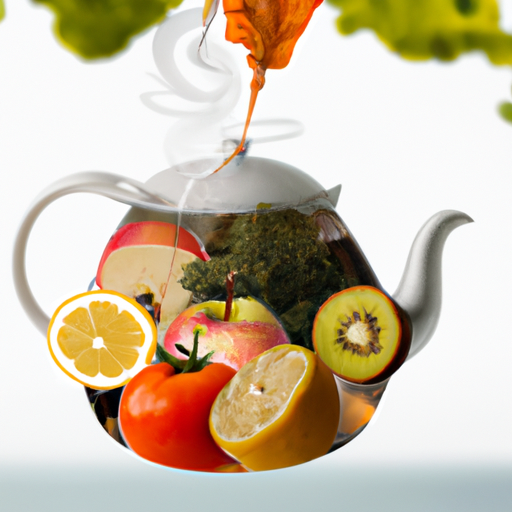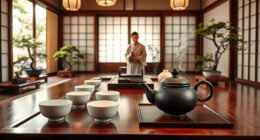As a tea lover, I understand the challenges of making the ideal cup of tea. One of the main problems for tea drinkers is the bitter taste that tannins can create.
Tannins are naturally occurring compounds found in tea leaves that give tea its astringent flavor. However, when steeped for too long or at too high a temperature, tannins can overwhelm the tea and make it unpleasant to drink.
In this article, I will share with you some tips on how to neutralize tannins in tea and enjoy a smooth and satisfying cup every time.
Firstly, it’s important to understand what tannins are and how they affect the taste of tea. Tannins are a type of polyphenol compound that can be found in tea, wine, and certain fruits. When steeped in hot water, tannins are released from the tea leaves and create a dry, bitter taste in the mouth.
While some people enjoy this flavor, others find it overwhelming. By following the tips in this article, you can learn how to control the amount of tannins in your tea and create a perfectly balanced cup that suits your taste preferences.
Key Takeaways
- Milk or cream can be added to neutralize tannins and enhance richness.
- Baking soda can be used sparingly to give a smoother taste.
- Tea blends can neutralize tannins and add unique flavors.
- Experimenting with different brewing methods and vessels can enhance flavors and aromas.
What are Tannins and Why They Make Tea Bitter
Do you know what tannins are and why they’re the reason your tea tastes bitter? Understanding tannins is essential to finding a solution to this problem.
Tannins are a type of polyphenol that is abundant in plants, especially tea leaves. They give the tea its distinctive astringent taste and are responsible for the bitter aftertaste that so many people dislike.
Tannins are also found in other beverages, such as wine and coffee. They are responsible for the dry feeling in your mouth after drinking wine and the bitterness in coffee. However, in moderate amounts, tannins can add complexity and body to a beverage, making it more enjoyable.
So, how can we enjoy tea without being put off by its bitter taste? The key is to choose the right tea leaves.
Choose the Right Tea Leaves
To get the perfect cup of tea, you’ll want to start by choosing the right tea leaves. The quality of the tea leaves you select will have a significant impact on the taste and overall experience of your brew.
There are many different types of tea leaves, including black, green, white, and oolong, each with its own unique flavor profile and tannin content. When choosing tea leaves, it’s important to opt for high-quality blends.
High-quality tea leaves are usually grown at higher altitudes and are harvested by hand. They’re also processed with care to preserve the natural flavor and aroma of the tea. By selecting high-quality blends, you can ensure that your tea will have a smoother taste and a lower tannin content, which will help to reduce the bitterness that tannins can cause.
With the right tea leaves, you’ll be on your way to enjoying a delicious cup of tea in no time. Now that you’ve selected your tea leaves, it’s time to control the temperature and steeping time to ensure that you get the best flavor possible.
Control the Temperature and Steeping Time
Controlling the temperature and steeping time is crucial in bringing out the fullest flavor and aroma of your tea. Temperature control is especially important when it comes to the tannins in your tea. These compounds can be bitter and astringent when over-extracted, ruining the taste of your tea. Steeping techniques also play a role in tannin extraction, so it’s important to understand how to control both variables to get the best cup of tea possible.
To ensure that your tea doesn’t become too bitter, there are a few things you can do to control the temperature and steeping time:
- Use water that’s just below boiling temperature for black teas, and slightly cooler for green and white teas.
- Steep your tea for the recommended amount of time. Over-steeping can result in over-extracted tannins.
- Consider using a timer or a tea infuser with a built-in timer to ensure that you don’t over-steep your tea.
By controlling these variables, you can create a perfectly brewed cup of tea that’s neither too bitter nor too weak.
Once you’ve mastered the art of temperature control and steeping techniques, you can move on to the next step: adding milk or cream to your tea.
Add Milk or Cream
If you want to enhance the creaminess and richness of your tea, you can add a splash of milk or cream. This not only improves the taste, but it can also help to neutralize tannins in the tea.
Tannins are naturally occurring compounds found in tea that can make it bitter and astringent, but the fat content in milk or cream can help to bind with the tannins and reduce their effects. When it comes to using cream or milk to neutralize tannins, both options can work well.
Cream has a higher fat content than milk, which means it can be more effective at neutralizing tannins. However, if you’re looking for a lighter option, milk can also do the trick. If you’re lactose intolerant or prefer non-dairy options, there are alternative milk options like almond milk or coconut milk that can also work to neutralize tannins.
Now, let’s move on to the next step of using filtered water for your tea.
Use Filtered Water
Using filtered water for your tea can make a significant difference in the overall taste and quality of your drink. When brewing tea, it’s important to consider the water source because tap water often contains impurities that can affect the flavor of your tea.
Using filtered water helps to remove chlorine, heavy metals, and other contaminants that can interfere with the natural taste of tea. One of the benefits of using filtered water for tea is that it can bring out the delicate flavors and aromas of the tea leaves. This is because filtered water is free from impurities that can mask the natural taste of tea.
Comparing filtered vs tap water for tea brewing, you’ll notice that filtered water produces a clearer, more vibrant brew with a smoother taste. Additionally, using filtered water can help to prevent the tea from becoming cloudy or murky, which can sometimes happen when using tap water.
By using filtered water for your tea, you’re taking a step towards achieving a more enjoyable tea-drinking experience. Adding a pinch of baking soda can also help to neutralize the tannins in your tea, which we’ll discuss in the next section.
Add a Pinch of Baking Soda
Adding a pinch of baking soda can give your tea a smoother taste and enhance its natural flavors, making for a more enjoyable drinking experience. However, it’s important to note that baking soda should be used sparingly, as too much can alter the flavor profile of your tea. If you don’t have baking soda on hand, there are other alternatives that can help neutralize tannins, such as adding a splash of milk or cream.
When using baking soda, add just a pinch to your tea and give it a stir. You may notice that the tea’s color changes slightly, becoming brighter and clearer. This is due to the alkaline properties of baking soda, which help to neutralize the acidic tannins in the tea. Keep in mind that the effects on flavor profile may vary depending on the type of tea you’re using, so it’s best to experiment with small amounts first to find the perfect balance of smoothness and taste.
To continue improving your tea drinking experience, try a tea infuser with a built-in strainer. This will allow you to brew loose tea leaves without any debris or leaves getting into your cup. By using a tea infuser, you can enjoy the full flavor and aroma of your tea without any unwanted bits floating around.
Try a Tea Infuser with a Built-in Strainer
You’ll love the convenience and ease of using a tea infuser with a built-in strainer. It allows you to brew your loose tea leaves without any unwanted bits floating around in your cup. Here are a few tea infuser benefits to consider:
-
Easy to use: Simply add your tea leaves to the infuser, steep in hot water, and enjoy a perfectly brewed cup of tea.
-
Affordable: Tea infusers are an inexpensive way to brew loose leaf tea and can be reused for years to come.
-
Portable: Tea infusers are compact and easy to take with you on the go, making it simple to enjoy your favorite tea wherever you are.
-
Environmentally friendly: By using a tea infuser, you can reduce waste by avoiding disposable tea bags and packaging.
If a tea infuser isn’t for you, there are alternative straining options available. However, keep in mind that a tea infuser with a built-in strainer is a convenient and reliable way to ensure a smooth and enjoyable tea drinking experience.
Now, let’s move on to the next step and explore the benefits of using tea blends to neutralize tannins in tea.
Use Tea Blends
As I mentioned earlier, using a tea infuser with a built-in strainer is an easy way to reduce the tannins in your tea. However, if you’re looking to add a little more flavor to your tea while also neutralizing its tannins, then tea blends might be the way to go.
Tea blends are mixtures of different types of tea leaves, herbs, and spices. They come in a variety of flavors and can be found in most specialty tea shops. Some tea blends are specifically designed to reduce tannins while others are blended for their unique flavor profiles.
Some popular tea blend recommendations for reducing tannins include White Peony (Bai Mu Dan), Silver Needle (Bai Hao Yinzhen), and Jasmine Dragon Phoenix Pearls.
By using tea blends, not only can you neutralize the tannins in your tea, but you can also enjoy the added benefits of the herbs and spices in the blends. For example, some blends are known for their calming properties, while others are believed to boost the immune system. So, there’s more to tea blending than just reducing tannins.
Speaking of getting the most out of your tea, the next step is to store tea properly to ensure that it stays fresh and flavorful.
Store Tea Properly
To keep your tea fresh and flavorful, it’s crucial to store it properly and avoid any unnecessary waste. Proper storage can increase the shelf life of your tea and preserve its aroma and taste.
Here are a few tips for storing your tea:
- Keep your tea away from sunlight, moisture, and strong odors. Exposure to these elements can affect the flavor and freshness of your tea.
- Use an airtight container to store your tea. This will prevent moisture and air from getting in and damaging the tea leaves.
- Store your tea in a cool, dry place. Avoid storing it in the fridge or freezer as the moisture and cold temperature can affect the flavor of the tea.
- Don’t store your tea for too long. Even if it’s stored properly, tea can lose its flavor and aroma over time. Try to consume your tea within six months to a year.
By following these storage tips, you can ensure that your tea stays fresh and flavorful for longer.
In the next section, we’ll discuss how to experiment with different methods to find your perfect cup.
Experiment with Different Methods and Find Your Perfect Cup
Ready to take your tea experience to the next level? Try experimenting with different brewing methods to find the perfect cup for you. Everyone has their own flavor preferences when it comes to tea, and finding the right brewing method can enhance the flavors and aromas that you enjoy most. Additionally, the impact of the brewing vessel can also play a role in the taste of your tea.
To help you get started on your tea experimentation journey, here is a table outlining different brewing methods and their recommended steep times:
| Brewing Method | Steep Time | Flavor Profile |
|---|---|---|
| Western Style | 3-5 minutes | Balanced |
| Gongfu Style | 10-30 seconds | Bold |
| Cold Brew | 12-24 hours | Smooth |
By trying out different brewing methods and steep times, you can find the perfect balance of flavors for your taste buds. And don’t forget to consider the vessel you’re using to brew your tea – clay pots, metal infusers, and glass teapots can all impact the taste and aroma of your tea. So go ahead and experiment – you might just discover your new favorite cup of tea.
Frequently Asked Questions
What are some common foods or drinks that also contain tannins?
Tannin-containing foods include red wine, grapes, pomegranates, and some types of nuts. The best ways to consume tannin-rich foods are in moderation and with a balanced diet.
Can tannins be harmful to your health if consumed in large amounts?
Overconsumption of tannins can have negative effects on the body, such as digestive issues and interference with iron absorption. However, tannin-rich foods and drinks have health benefits such as antioxidant properties and potential cancer prevention.
How can you tell if a tea has high levels of tannins before brewing it?
When it comes to pre-brew tea tannin testing, the color of the tea can give a clue. Darker teas tend to have higher levels of tannins. Alternatively, try tannin-free tea alternatives such as herbal teas.
Are there any natural ingredients that can be added to tea to neutralize tannins?
Natural remedies can be used to reduce tannins in tea, such as adding a small amount of baking soda or milk. However, the effectiveness of tannin reduction methods varies depending on the type of tea and personal preference.
Is it possible to remove tannins from already brewed tea?
Removing tannins from already brewed tea can be difficult, with no guaranteed effective methods. However, it can impact the flavor, making it less bitter and astringent. It’s best to focus on preventing excessive tannin extraction during brewing.
Conclusion
In conclusion, tannins can be tamed with a little bit of knowledge and experimentation. By selecting the right tea leaves, controlling the temperature and steeping time, and adding milk or cream, you can make a bitter cup of tea much more palatable.
Using filtered water, a tea infuser with a built-in strainer, and storing your tea properly can also help to reduce the tannins in your tea. Don’t be afraid to try different tea blends and methods to find your perfect cup.
As the saying goes, "practice makes perfect,"and the same goes for brewing tea. By practicing these techniques and experimenting with different methods, you can become a tea brewing expert in no time.
So, sit back, relax, and enjoy your perfectly brewed cup of tea, knowing that you have the tools and knowledge to neutralize those pesky tannins. Cheers to a great cup of tea!










